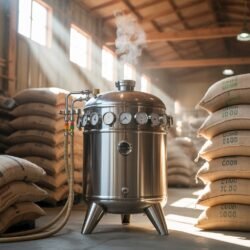Anaerobic fermentation is transforming the specialty coffee scene, resulting in cups bursting with vibrant fruit, winey acidity, and unforgettable depth. But how exactly does this innovative process work? Let’s walk through each stage, from cherry selection to your morning brew.
1. Cherry Selection and Sorting
Every great coffee starts with quality fruit. Producers begin by hand-picking only the ripest, healthiest cherries. To ensure optimal sugar content—a key driver for flavor—many use a Brix meter to measure the cherries’ sweetness. Damaged or underripe cherries are carefully removed, as even a few bad ones can spoil the batch and introduce off-flavors.
2. Cleaning and Preparation
Once selected, the cherries are thoroughly washed to remove dirt, debris, and any lingering pesticides. This step is crucial for maintaining a clean fermentation environment and minimizing the risk of contamination by unwanted microbes.
3. Loading the Fermentation Tank
The cleaned cherries are loaded into a sealed fermentation tank. Some producers go a step further by injecting carbon dioxide (CO₂) into the tank to immediately remove oxygen. Others simply seal the tank and rely on the cherries’ natural fermentation process to produce CO₂, which pushes out oxygen through a one-way valve.
4. Sealing and Creating an Oxygen-Free Environment
With the cherries inside, the tank is tightly sealed. The goal is to create a completely anaerobic (oxygen-free) environment. As fermentation begins, CO₂ is released as a byproduct, further purging any remaining oxygen through the valve. This sealed environment is what sets anaerobic processing apart and allows for unique flavor development.
5. Monitoring Fermentation
Fermentation typically lasts between 24 and 96 hours, depending on the desired flavor profile. During this time, producers keep a close eye on several key factors:
- Temperature: Maintained within a specific range (often 23–28°C) to encourage beneficial microbial activity.
- pH: Monitored to ensure the environment remains suitable for fermentation.
- Gas Release: The one-way valve allows CO₂ to escape, maintaining the anaerobic environment.
- Fermentation Progress: Some producers check the liquid content or Brix levels in the tank to assess how the fermentation is progressing.
6. Post-Fermentation Processing
After fermentation, the cherries can be processed in different ways, each influencing the final flavor:
- Natural (Dry): The cherries are dried whole, with the fruit still attached.
- Honey: The cherries are de-pulped, but some mucilage remains during drying.
- Washed: The cherries are de-pulped and washed to remove all mucilage before drying.
The choice of method will shape the coffee’s final character, with each offering its own unique profile.
7. Drying the Coffee
Regardless of the post-fermentation method, the next step is drying. The beans are spread out on raised beds, patios, or in mechanical dryers. They are turned regularly to ensure even drying and to prevent mold or uneven fermentation. Drying can take anywhere from several days to a few weeks, depending on the climate and method.
8. Resting and Milling
Once dried, the coffee is rested in airtight containers, such as GrainPro bags, to allow flavors to stabilize. After resting, the beans are milled to remove the parchment layer, resulting in green coffee ready for export or roasting.
9. Roasting and Brewing
Finally, the green coffee is roasted and brewed. Anaerobically processed coffee is celebrated for its unique, complex flavors—think bright fruit, wine-like acidity, and unexpected aromatic notes. Whether enjoyed as a pour-over, espresso, or cold brew, these coffees offer a taste experience like no other.
Wrapping Up
Anaerobic coffee processing is a blend of science and artistry, requiring careful attention at every stage. From cherry selection to final brew, each step plays a crucial role in crafting the bold, complex flavors that have made anaerobic coffee a favorite among specialty coffee lovers.


